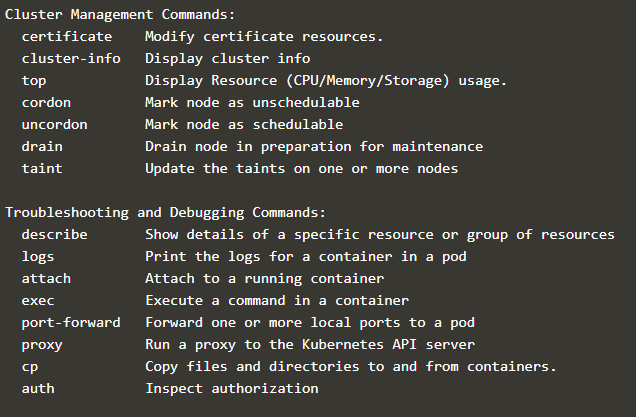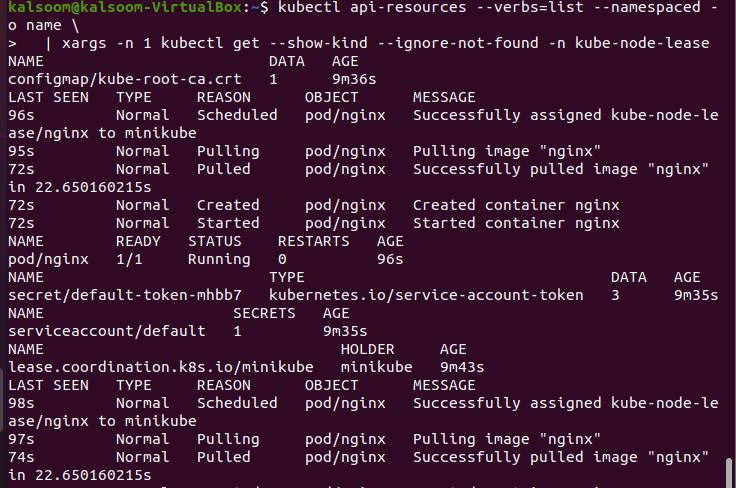Kubectl Command Lists One or More Resources
Kubectl taint node List one or more nodes. List all namespace services.

Kubectl Cheat Sheet Kubernetes Cheat Sheets Cheating Sheet
Kubectl api-resources --verbs list --namespaced -o name xargs -n 1 kubectl get --show-kind --ignore-not-found -n kube-node-lease.

. Specifies the operation that you want to perform on one or more resources create get describe delete type. Kubectl get pods. This means you can combine it with kubectl get to actually list every instance of every resource type in a namespace.
These are actually different versions of the same resource in different API groups. As a result we can use it in conjunction with kubectl get to acquire a list of all instances of each resource type in a Kubernetes namespace. Kubectl api-resources enumerates the resource types available in your cluster.
Specifies the name of the resource. The most common Kubernetes objects you are likely to query are pods services deployments stateful sets and secrets. Kubectl command lists one or more resources.
When admins add a wide output flag such as kubectl get pods -o wide it lists the pods with associated node names and other information. Kubectl command TYPE NAME flags command. Kubectl top node.
Kubectl get is probably the command you will use the most so it deserves its own section. To list one or more pods replication controllers services or daemon sets use the kubectl get command. Furthermost resources contain a kubectl get process.
Resource allocation per node. Kubectl get node. Kubectl get can retrieve information about all Kubernetes objects as well as nodes in the Kubernetes data plane.
List one or more resources. Now its time to jump into our command roundup. For too many resources present in a namespace this command can take some time.
KEY_NVAL_N --overwrite --all --resource-versionversion flags Add or update the labels of one or more resources. Kubectl logs my-pod dump pod logs stdout kubectl logs -l name myLabel dump pod logs with label namemyLabel stdout kubectl logs my-pod --previous dump pod logs stdout for a previous instantiation of a container kubectl logs my-pod -c my-container dump pod container logs stdout multi-container case kubectl logs -l name myLabel -c my-container dump pod. To list a specific replication controller run the following command.
And even then that assumes an exact 1-to-1 mapping between API endpoints and kubectl commands which I doubt is always the case. Instead of executing the kubectl get command on every type of resource we may execute it on many resources simultaneously. C All of the these.
Resource types are case-insensitive and you can specify the singular plural or abbreviated forms. These commands will help you better manage and understand your Kubernetes deployment as it evolves. Once you find the right resource you would need to know the correct YAML schema so its configuration can be applied.
Kubectl top node node Name. This Question is related to K8s and was asked during one of the Course in Fresco. Kubectl delete node Display Resource usage CPUMemoryStorage for nodes.
10 Recommended Kubectl Commands. In general when new resource types are introduced to Kubernetes they are first managed in the extensions API group iterating through multiple versions. The kubectl get pods command lists all pods under Kubernetes.
By this method we obtain the resource when deploying the API form and group. List all resources with more details. Here is the command you can use.
Based on this comment the supported way to list all resources is to iterate through all the api versions listed by kubectl api-resources. One thing that could help on this document would be a section on the right column under kubectl command that shows exactly the rule needed in an RBAC role to allow this command via kubectl. The top command allows you to see the resource consumption for nodes.
The get operation also lists resources like replication controllers and services. Ive included a variety of command types and explained each so youve got a quick cheat sheet readily available. Once the resources are regarded stable they are moved to a stable API group such as apps or networkingk8sio explained.
You can use kubectl create command to create a resource such as a service a deployment a job or a namespace. Kubectl label -f FILENAME TYPE NAME TYPENAME KEY_1VAL_1. Kubectl get pods -o wide Generate a list of all pods.
Pods running on a node. Kubectl api-resources --verbslist -o name xargs -n 1 kubectl get -o name. In 111 kuberneteskubernetes63254 added the ability to list all resource types in a format that can be used with kubectl get.
Generate a plain-text list of all namespaces. We can also add parameters--all-namespaces. Kubectl get replicationcontroller replication-controller-name To list all replication controllers and services run the following command.
Pods services deployments cronjobs events ingresses etc. Select the Correct Answer from below option. Schemas can be lengthy and difficult to memorize.
Kubectl command lists one or more resources. Kubectl set resources -f FILENAME TYPE NAME --limits LIMITS -- requests REQUESTS kubectl set resources deployment tomcat -c tomcat -- limits cpu 200mmemory 512Mi kubectl top node It displays CPUMemoryStorage usage. Update the taints on one or more nodes.
Specifies the resource type. This command works for all types of Kubernetes resources. Kubectl logs POD -c CONTAINER --follow flags Print the logs for a container in a pod.
List all resources of all namespaces-o wide. Kubectl api-resources --verbslist --namespaced -o name xargs -n 1 kubectl get --show-kind --ignore-not-found -n In the code above provide your namespace in place of and can run the above command. Kubectl get namespace Generate a plain-text list of all pods.
To get further information about API in Kubernetes we have to see if a specific groupform is accessible for a source. This command lists pods on the Kubernetes cluster. Kubectl get pods Generate a detailed plain-text list of all pods.
Luckily using the kubectl api-resources command you could search through all of the registered API resources to find the right one. The kubectl get operation lists one or more Kubernetes resources. You can use the following command.
Kubectl describe nodes grep Allocated -A 5. Delete a node or multiple nodes. Choose the correct option from below list 1list 2get 3All of the these 4desc Answer-2get.

Kubernetes Kubectl Syntax And Examples Of Kubernetes Kubectl

Ready To Use Commands And Tips For Kubectl Flant Blog


No comments for "Kubectl Command Lists One or More Resources"
Post a Comment